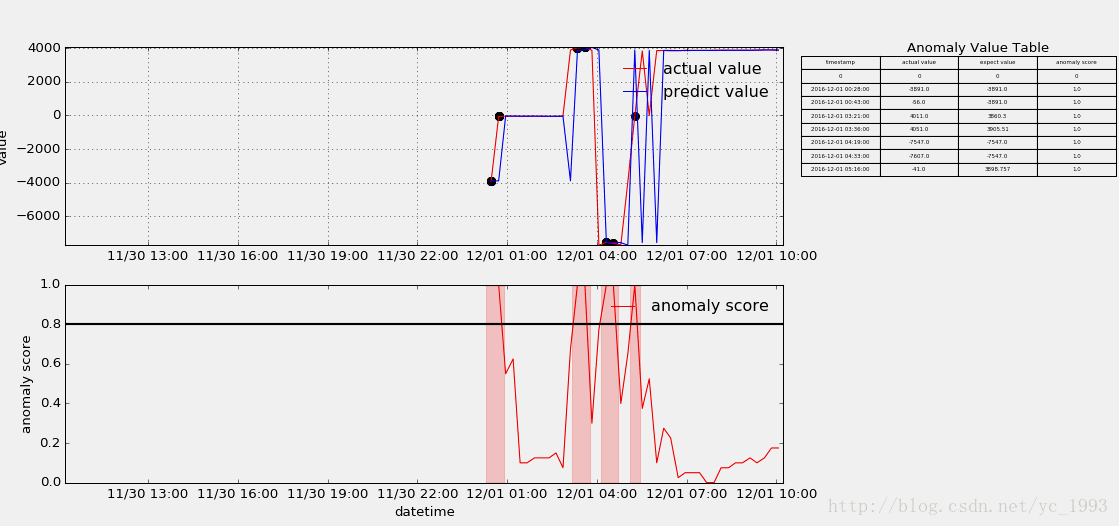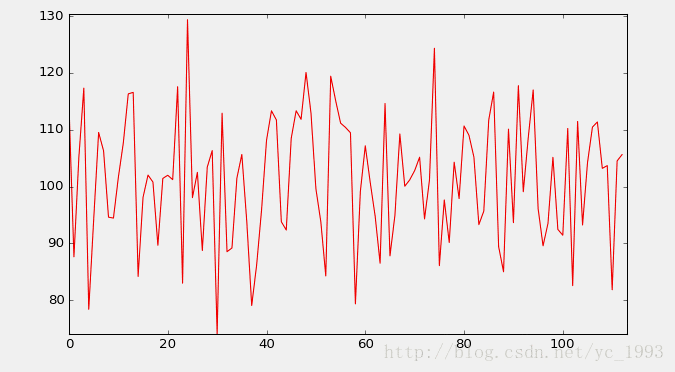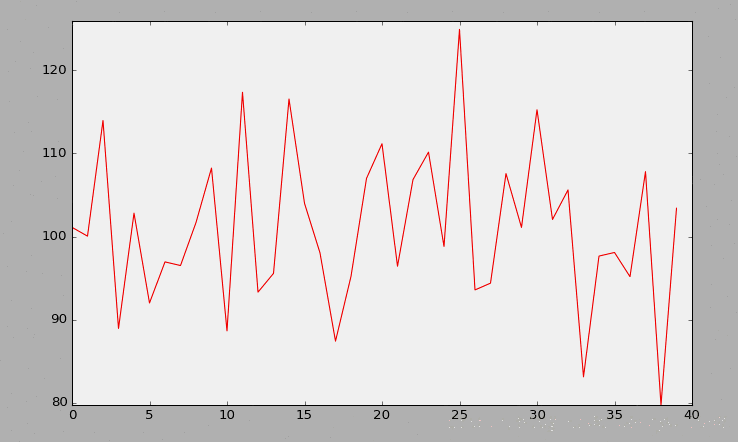您好,登錄后才能下訂單哦!
您好,登錄后才能下訂單哦!
preface
流式數據的監控,以下主要是從算法的呈現出發,提供一種python的實現思路
其中:
1.python是2.X版本
2.提供兩種實現思路,一是基于matplotlib的animation,一是基于matplotlib的ion
話不多說,先了解大概的效果,如下:

一、一點構思
在做此流數據輸出可視化前,一直在搗鼓nupic框架,其內部HTM算法主要是一種智能的異常檢測算法,是目前AI框架中垂直領域下的一股清流,但由于其實現的例子對應的流數據展示并非我想要的,故此借鑒后自己重新寫了一個,主要是達到三個目的,一是展示真實數據的波動,二是展示各波動的異常得分,三是羅列異常的點。
上述的輸出結構并非重點,重點是其實時更新的機制,了解后即可自行定義。另,js對于這種流數據展示應該不難,所以本文主要立足的是算法的呈現角度以及python的實現。
二、matplotlib animation實現思路
http://matplotlib.org/api/animation_api.html 鏈接是matplotlib animation的官方api文檔
(一)、骨架與實時更新
animation翻譯過來就是動畫,其動畫展示核心主要有三個:1是動畫的骨架先搭好,就是圖像的邊邊框框這些,2是更新的過程,即傳入實時數據時圖形的變化方法,3是FuncAnimation方法結尾。
下面以一個小例子做進一步說明:
1.對于動畫的骨架:
# initial the figure. x = [] y = [] fig = plt.figure(figsize=(18, 8), facecolor="white") ax1 = fig.add_subplot(111) p1, = ax1.plot(x, y, line, color="red")
以上分別對應初始化空數據,初始化圖形大小和背景顏色,插入子圖(三個數字分別表示幾行幾列第幾個位置),初始化圖形(數據為空)。
import numpy as np x = np.arange(0, 1000, 1) y = np.random.normal(100, 10, 1000)
隨機生成一些作圖數據,下面定義update過程。
2.對于更新過程:
def update(i): x.append(xs[i]) y.append(ys[i]) ax1.set_xlim(min(x),max(x)+1) ax1.set_ylim(min(y),max(y)+1) p1.set_data(x,y) ax1.figure.canvas.draw() return p1
上述定義更新函數,參數i為每輪迭代從FuncAnimation方法frames參數傳進來的數值,frames參數的指定下文會進一步說,x/y通過相應更新之后,對圖形的x/y軸大小做相應的重設,再把數據通過set_data傳進圖形,注意ax1和p1的區別,最后再把上述的變化通過draw()方法繪制到界面上,返回p1給FuncAnimation方法。
3.對于FuncAnimation方法:
ani = FuncAnimation(fig=fig,func=update,frames=len(xs),interval=1) plt.show()
FuncAnimation方法主要是與update函數做交互,將frames參數對應的數據逐條傳進update函數,再由update函數返回的圖形覆蓋FuncAnimation原先的圖形,fig參數即為一開始對應的參數,interval為每次更新的時間間隔,還有其他一些參數如blit=True控制圖形精細,當界面較多子圖時,為True可以使得看起來不會太卡,關鍵是frames參數,下面是官方給出的注釋:

可為迭代數,可為函數,也可為空,上面我指定為數組的長度,其迭代則從0開始到最后該數值停止。
該例子最終呈現的效果如下:

了解大概的實現,細節就不在這里多說了。
(二)、animation的優缺點
animation的繪制的結果相比于下文的ion會更加的細膩,主要體現在FuncAnimation方法的一些參數的控制上。但是缺點也是明顯,就是必須先有指定的數據或者指定的數據大小,顯然這樣對于預先無法知道數據的情況沒法處理。所以換一種思路,在matplotlib ion打開的模式下,每次往模板插入數據都會進行相應的更新,具體看第二部分。
三、matplotlib ion實現思路
(一)、實時更新
matplotlib ion的實現也主要是三個核心,1是打開ion,2是實時更新機制,3是呈現在界面上。
1.對于打開ion:
ion全稱是 interactive on(交互打開),其意為打開一個圖形的交互接口,之后每次繪圖都在之前打開的面板上操作,舉個例子:
import matplotlib.pyplot as plt plt.ion() fig = plt.figure() ax1 = fig.add_subplot(111) line, = ax1.plot(t, v, line, color="r")
打開交互接口,初始化圖形。
2.對于實時更新機制:
import numpy as np ys = np.random.normal(100, 10, 1000) def p(a, b): t.append(a) v.append(b) ax1.set_xlim(min(t), max(t) + 1) ax1.set_ylim(min(v), max(v) + 1) line.set_data(t, v) plt.pause(0.001) ax1.figure.canvas.draw() for i in xrange(len(ys)): p(i, ys[i])
隨機生成一組數據,定義作圖函數p(包含pause表示暫定時延,最好有,防止界面卡死),傳入數據實時更新。
3.對于界面最終呈現
plt.ioff() plt.show()
ioff是關閉交互模式,就像open打開文件產生的句柄,最好也有個close關掉。
最終效果如下:

(二)、ion的優缺點
animation可以在細節上控制比ion更加細膩,這也是ion沒有的一點,但是單就無需預先指定數據這一點,ion也無疑是能把流數據做得更加好。
四、最后
貼一下兩種方法在最開始那種圖的做法,ion我定義成類,這樣每次調用只需穿入參數就可以。
animation版本
# _*_ coding:utf-8 _*_
import os
import csv
import datetime
import matplotlib.pyplot as plt
from matplotlib.animation import FuncAnimation
from matplotlib.dates import DateFormatter
import matplotlib.ticker as ticker
# read the file
filePath = os.path.join(os.getcwd(), "data/anomalyDetect_output.csv")
file = open(filePath, "r")
allData = csv.reader(file)
# skip the first three columns
allData.next()
allData.next()
allData.next()
# cache the data
data = [line for line in allData]
# for i in data: print i
# take out the target value
timestamp = [line[0] for line in data]
value = [line[1:] for line in data]
# format the time style 2016-12-01 00:00:00
def timestampFormat(t):
result = datetime.datetime.strptime(t, "%Y-%m-%d %H:%M:%S")
return result
# take out the data
timestamp = map(timestampFormat, timestamp)
value_a = [float(x[0]) for x in value]
predict_a = [float(x[1]) for x in value]
anomalyScore_a = [float(x[2]) for x in value]
# initial the size of the figure
fig = plt.figure(figsize=(18, 8), facecolor="white")
fig.subplots_adjust(left=0.06, right=0.70)
ax1 = fig.add_subplot(2, 1, 1)
ax2 = fig.add_subplot(2, 1, 2)
ax3 = fig.add_axes([0.8, 0.1, 0.2, 0.8], frameon=False)
# initial plot
p1, = ax1.plot_date([], [], fmt="-", color="red", label="actual")
ax1.legend(loc="upper right", frameon=False)
ax1.grid(True)
p2, = ax2.plot_date([], [], fmt="-", color="red", label="anomaly score")
ax2.legend(loc="upper right", frameon=False)
ax2.axhline(0.8, color='black', lw=2)
# add the x/y label
ax2.set_xlabel("date time")
ax2.set_ylabel("anomaly score")
ax1.set_ylabel("value")
# add the table in ax3
col_labels = ["date time", 'actual value', 'predict value', 'anomaly score']
ax3.text(0.05, 0.99, "anomaly value table", size=12)
ax3.set_xticks([])
ax3.set_yticks([])
# axis format
dateFormat = DateFormatter("%m/%d %H:%M")
ax1.xaxis.set_major_formatter(ticker.FuncFormatter(dateFormat))
ax2.xaxis.set_major_formatter(ticker.FuncFormatter(dateFormat))
# define the initial function
def init():
p1.set_data([], [])
p2.set_data([], [])
return p1, p2
# initial data for the update function
x1 = []
x2 = []
x1_2 = []
y1_2 = []
x1_3 = []
y1_3 = []
y1 = []
y2 = []
highlightList = []
turnOn = True
tableValue = [[0, 0, 0, 0]]
# update function
def stream(i):
# update the main graph(contains actual value and predicted value)
# add the data
global turnOn, highlightList, ax3
x1.append(timestamp[i])
y1.append(value_a[i])
# update the axis
minAxis = max(x1) - datetime.timedelta(days=1)
ax1.set_xlim(minAxis, max(x1))
ax1.set_ylim(min(y1), max(y1))
ax1.figure.canvas.draw()
p1.set_data(x1, y1)
# update the anomaly graph(contains anomaly score)
x2.append(timestamp[i])
y2.append(anomalyScore_a[i])
ax2.set_xlim(minAxis, max(x2))
ax2.set_ylim(min(y2), max(y2))
# update the scatter
if anomalyScore_a[i] >= 0.8:
x1_3.append(timestamp[i])
y1_3.append(value_a[i])
ax1.scatter(x1_3, y1_3, s=50, color="black")
# update the high light
if anomalyScore_a[i] >= 0.8:
highlightList.append(i)
turnOn = True
else:
turnOn = False
if len(highlightList) != 0 and turnOn is False:
ax2.axvspan(timestamp[min(highlightList)] - datetime.timedelta(minutes=10),
timestamp[max(highlightList)] + datetime.timedelta(minutes=10),
color='r',
edgecolor=None,
alpha=0.2)
highlightList = []
turnOn = True
p2.set_data(x2, y2)
# add the table in ax3
# update the anomaly tabel
if anomalyScore_a[i] >= 0.8:
ax3.remove()
ax3 = fig.add_axes([0.8, 0.1, 0.2, 0.8], frameon=False)
ax3.text(0.05, 0.99, "anomaly value table", size=12)
ax3.set_xticks([])
ax3.set_yticks([])
tableValue.append([timestamp[i].strftime("%Y-%m-%d %H:%M:%S"), value_a[i], predict_a[i], anomalyScore_a[i]])
if len(tableValue) >= 40: tableValue.pop(0)
ax3.table(cellText=tableValue, colWidths=[0.35] * 4, colLabels=col_labels, loc=1, cellLoc="center")
return p1, p2
# main animated function
anim = FuncAnimation(fig, stream, init_func=init, frames=len(timestamp), interval=0)
plt.show()
file.close()
ion版本
#! /usr/bin/python
import os
import csv
import datetime
import matplotlib.pyplot as plt
from matplotlib.animation import FuncAnimation
from matplotlib.dates import DateFormatter
import matplotlib.ticker as ticker
class streamDetectionPlot(object):
"""
Anomaly plot output.
"""
# initial the figure parameters.
def __init__(self):
# Turn matplotlib interactive mode on.
plt.ion()
# initial the plot variable.
self.timestamp = []
self.actualValue = []
self.predictValue = []
self.anomalyScore = []
self.tableValue = [[0, 0, 0, 0]]
self.highlightList = []
self.highlightListTurnOn = True
self.anomalyScoreRange = [0, 1]
self.actualValueRange = [0, 1]
self.predictValueRange = [0, 1]
self.timestampRange = [0, 1]
self.anomalyScatterX = []
self.anomalyScatterY = []
# initial the figure.
global fig
fig = plt.figure(figsize=(18, 8), facecolor="white")
fig.subplots_adjust(left=0.06, right=0.70)
self.actualPredictValueGraph = fig.add_subplot(2, 1, 1)
self.anomalyScoreGraph = fig.add_subplot(2, 1, 2)
self.anomalyValueTable = fig.add_axes([0.8, 0.1, 0.2, 0.8], frameon=False)
# define the initial plot method.
def initPlot(self):
# initial two lines of the actualPredcitValueGraph.
self.actualLine, = self.actualPredictValueGraph.plot_date(self.timestamp, self.actualValue, fmt="-",
color="red", label="actual value")
self.predictLine, = self.actualPredictValueGraph.plot_date(self.timestamp, self.predictValue, fmt="-",
color="blue", label="predict value")
self.actualPredictValueGraph.legend(loc="upper right", frameon=False)
self.actualPredictValueGraph.grid(True)
# initial two lines of the anomalyScoreGraph.
self.anomalyScoreLine, = self.anomalyScoreGraph.plot_date(self.timestamp, self.anomalyScore, fmt="-",
color="red", label="anomaly score")
self.anomalyScoreGraph.legend(loc="upper right", frameon=False)
self.baseline = self.anomalyScoreGraph.axhline(0.8, color='black', lw=2)
# set the x/y label of the first two graph.
self.anomalyScoreGraph.set_xlabel("datetime")
self.anomalyScoreGraph.set_ylabel("anomaly score")
self.actualPredictValueGraph.set_ylabel("value")
# configure the anomaly value table.
self.anomalyValueTableColumnsName = ["timestamp", "actual value", "expect value", "anomaly score"]
self.anomalyValueTable.text(0.05, 0.99, "Anomaly Value Table", size=12)
self.anomalyValueTable.set_xticks([])
self.anomalyValueTable.set_yticks([])
# axis format.
self.dateFormat = DateFormatter("%m/%d %H:%M")
self.actualPredictValueGraph.xaxis.set_major_formatter(ticker.FuncFormatter(self.dateFormat))
self.anomalyScoreGraph.xaxis.set_major_formatter(ticker.FuncFormatter(self.dateFormat))
# define the output method.
def anomalyDetectionPlot(self, timestamp, actualValue, predictValue, anomalyScore):
# update the plot value of the graph.
self.timestamp.append(timestamp)
self.actualValue.append(actualValue)
self.predictValue.append(predictValue)
self.anomalyScore.append(anomalyScore)
# update the x/y range.
self.timestampRange = [min(self.timestamp), max(self.timestamp)+datetime.timedelta(minutes=10)]
self.actualValueRange = [min(self.actualValue), max(self.actualValue)+1]
self.predictValueRange = [min(self.predictValue), max(self.predictValue)+1]
# update the x/y axis limits
self.actualPredictValueGraph.set_ylim(
min(self.actualValueRange[0], self.predictValueRange[0]),
max(self.actualValueRange[1], self.predictValueRange[1])
)
self.actualPredictValueGraph.set_xlim(
self.timestampRange[1] - datetime.timedelta(days=1),
self.timestampRange[1]
)
self.anomalyScoreGraph.set_xlim(
self.timestampRange[1]- datetime.timedelta(days=1),
self.timestampRange[1]
)
self.anomalyScoreGraph.set_ylim(
self.anomalyScoreRange[0],
self.anomalyScoreRange[1]
)
# update the two lines of the actualPredictValueGraph.
self.actualLine.set_xdata(self.timestamp)
self.actualLine.set_ydata(self.actualValue)
self.predictLine.set_xdata(self.timestamp)
self.predictLine.set_ydata(self.predictValue)
# update the line of the anomalyScoreGraph.
self.anomalyScoreLine.set_xdata(self.timestamp)
self.anomalyScoreLine.set_ydata(self.anomalyScore)
# update the scatter.
if anomalyScore >= 0.8:
self.anomalyScatterX.append(timestamp)
self.anomalyScatterY.append(actualValue)
self.actualPredictValueGraph.scatter(
self.anomalyScatterX,
self.anomalyScatterY,
s=50,
color="black"
)
# update the highlight of the anomalyScoreGraph.
if anomalyScore >= 0.8:
self.highlightList.append(timestamp)
self.highlightListTurnOn = True
else:
self.highlightListTurnOn = False
if len(self.highlightList) != 0 and self.highlightListTurnOn is False:
self.anomalyScoreGraph.axvspan(
self.highlightList[0] - datetime.timedelta(minutes=10),
self.highlightList[-1] + datetime.timedelta(minutes=10),
color="r",
edgecolor=None,
alpha=0.2
)
self.highlightList = []
self.highlightListTurnOn = True
# update the anomaly value table.
if anomalyScore >= 0.8:
# remove the table and then replot it
self.anomalyValueTable.remove()
self.anomalyValueTable = fig.add_axes([0.8, 0.1, 0.2, 0.8], frameon=False)
self.anomalyValueTableColumnsName = ["timestamp", "actual value", "expect value", "anomaly score"]
self.anomalyValueTable.text(0.05, 0.99, "Anomaly Value Table", size=12)
self.anomalyValueTable.set_xticks([])
self.anomalyValueTable.set_yticks([])
self.tableValue.append([
timestamp.strftime("%Y-%m-%d %H:%M:%S"),
actualValue,
predictValue,
anomalyScore
])
if len(self.tableValue) >= 40: self.tableValue.pop(0)
self.anomalyValueTable.table(cellText=self.tableValue,
colWidths=[0.35] * 4,
colLabels=self.anomalyValueTableColumnsName,
loc=1,
cellLoc="center"
)
# plot pause 0.0001 second and then plot the next one.
plt.pause(0.0001)
plt.draw()
def close(self):
plt.ioff()
plt.show()
下面是ion版本的調用:
graph = stream_detection_plot.streamDetectionPlot() graph.initPlot() for i in xrange(len(timestamp)): graph.anomalyDetectionPlot(timestamp[i],value_a[i],predict_a[i],anomalyScore_a[i]) graph.close()
具體為實例化類,初始化圖形,傳入數據作圖,關掉。
以上就是本文的全部內容,希望對大家的學習有所幫助,也希望大家多多支持億速云。
免責聲明:本站發布的內容(圖片、視頻和文字)以原創、轉載和分享為主,文章觀點不代表本網站立場,如果涉及侵權請聯系站長郵箱:is@yisu.com進行舉報,并提供相關證據,一經查實,將立刻刪除涉嫌侵權內容。